Energy-efficient windows are designed to lower energy costs by minimizing heat transfer and enhancing insulation, which leads to reduced heating and cooling needs. They also provide significant noise reduction and UV protection, making indoor spaces more comfortable and preserving furnishings from harmful radiation.
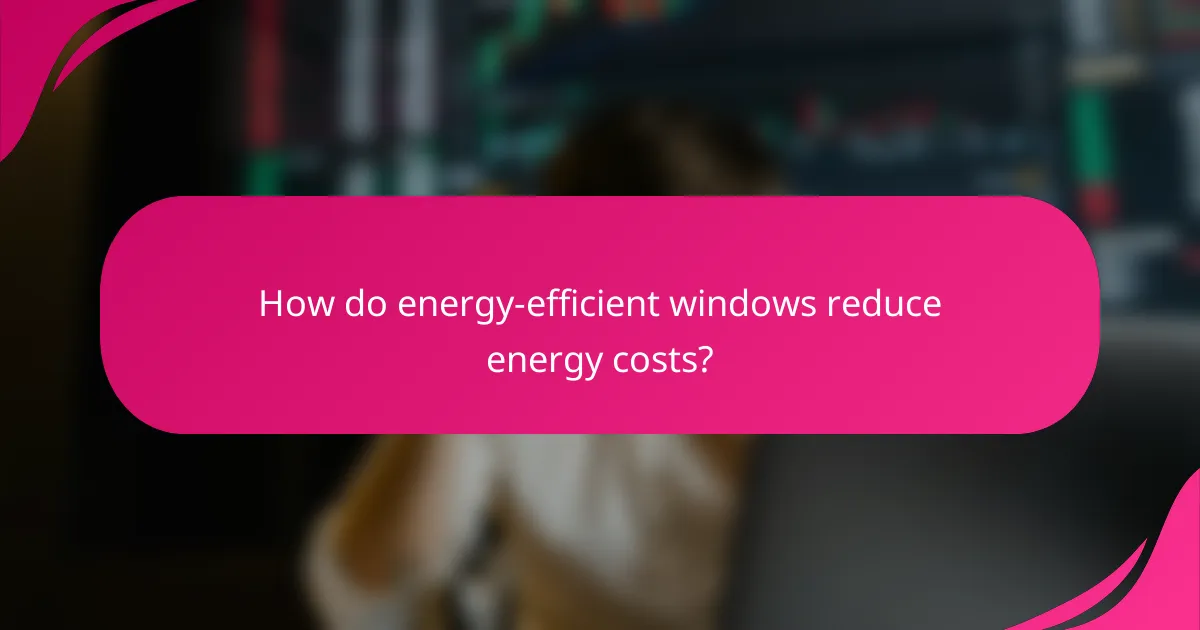
How do energy-efficient windows reduce energy costs?
Energy-efficient windows lower energy costs by minimizing heat transfer and improving insulation, which reduces the need for heating and cooling. By using advanced materials and technologies, these windows help maintain a comfortable indoor temperature, leading to significant savings on energy bills.
Low U-factor for better insulation
The U-factor measures how well a window insulates, with lower values indicating better insulation properties. Energy-efficient windows typically have a U-factor ranging from 0.20 to 0.30, which significantly reduces heat loss in winter and heat gain in summer. Choosing windows with a low U-factor can lead to noticeable reductions in heating and cooling expenses.
When selecting windows, consider the climate in your area. In colder regions, a U-factor closer to 0.20 is ideal, while milder climates may benefit from slightly higher values. Always check the manufacturer’s specifications to ensure compliance with local energy codes.
Solar heat gain coefficient benefits
The solar heat gain coefficient (SHGC) measures how much solar radiation passes through a window. Energy-efficient windows often have a SHGC of 0.25 to 0.40, allowing for natural light while minimizing unwanted heat gain. This balance helps keep indoor spaces cooler in the summer, reducing reliance on air conditioning.
For homes in sunny areas, selecting windows with a lower SHGC can help maintain comfort and lower energy costs. Conversely, in colder climates, a higher SHGC might be beneficial to capture solar heat during winter months.
Energy Star certification advantages
Energy Star-certified windows meet strict energy efficiency guidelines set by the U.S. Environmental Protection Agency. These windows provide superior insulation and energy performance, often resulting in savings of 10-15% on energy bills compared to non-certified options. Investing in Energy Star windows can also qualify homeowners for rebates and tax credits in some regions.
When shopping for windows, look for the Energy Star label to ensure you are choosing products that meet high efficiency standards. This certification not only helps in reducing energy costs but also contributes to environmental sustainability by lowering overall energy consumption.
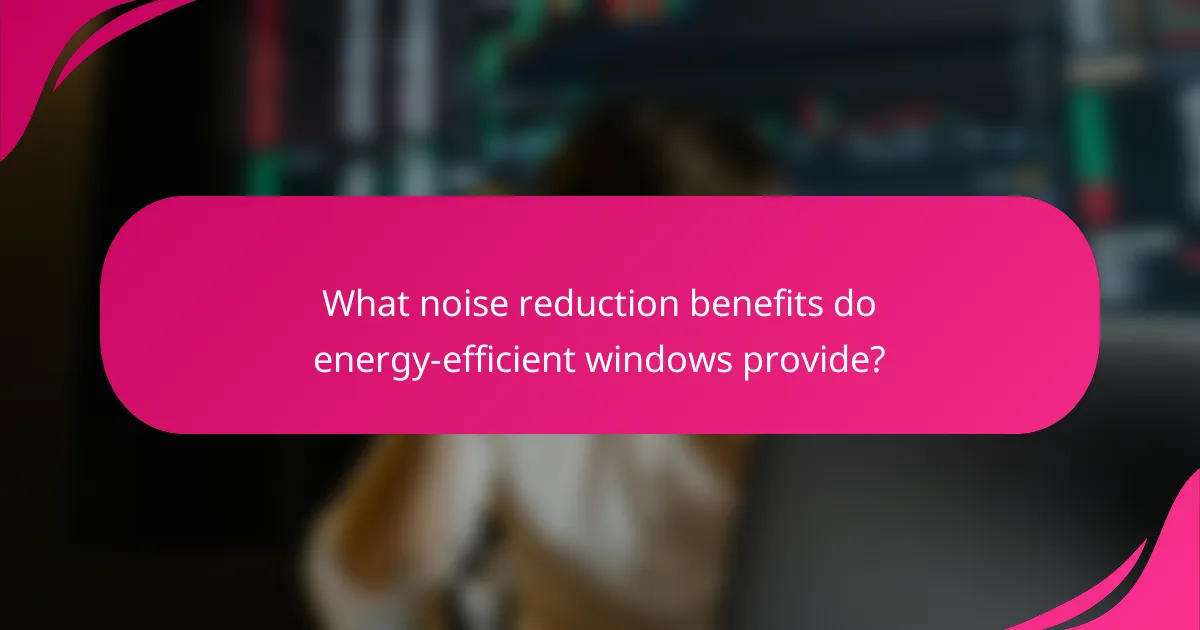
What noise reduction benefits do energy-efficient windows provide?
Energy-efficient windows significantly reduce noise pollution by incorporating advanced materials and designs that block sound transmission. This results in a quieter indoor environment, enhancing comfort and quality of life, especially in urban areas or near busy roads.
Double glazing for sound insulation
Double glazing consists of two panes of glass separated by a space filled with air or gas, which acts as an insulator against sound. This design can reduce noise levels by up to 30% compared to single-pane windows. When selecting double glazing, consider the thickness of the glass and the width of the gap between panes, as these factors can influence sound insulation performance.
For optimal noise reduction, look for double-glazed windows with a higher sound transmission class (STC) rating, typically ranging from 28 to 40. Installing these windows can be particularly beneficial in homes located in noisy neighborhoods or near airports.
Acoustic glass options
Acoustic glass is specifically engineered to minimize sound transmission, making it an excellent choice for those seeking enhanced noise reduction. This type of glass often features varying thicknesses and specialized interlayers that absorb sound waves more effectively than standard glass. Acoustic glass can reduce noise by 50% or more, depending on its construction.
When considering acoustic glass, evaluate its STC rating, which should ideally be above 35 for significant noise reduction. While it may come at a higher cost than standard options, the investment can lead to a more peaceful living space, particularly in high-traffic areas.
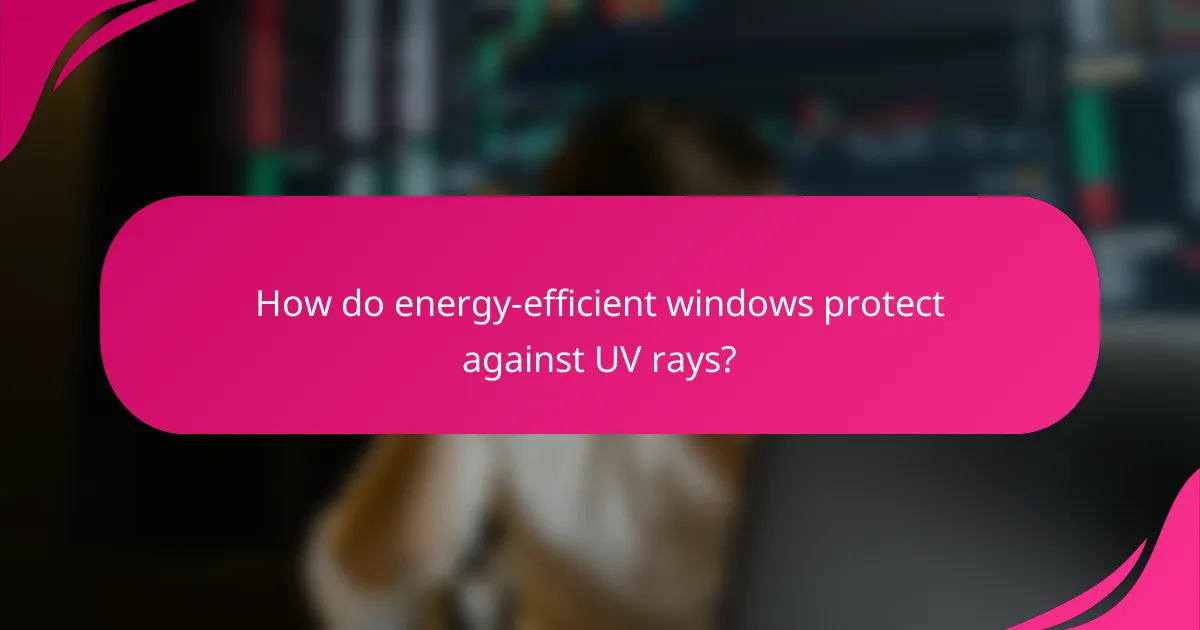
How do energy-efficient windows protect against UV rays?
Energy-efficient windows protect against UV rays primarily through specialized coatings that filter harmful radiation. These coatings significantly reduce UV exposure, helping to preserve indoor furnishings and maintain a comfortable living environment.
Low-E coatings for UV filtration
Low-Emissivity (Low-E) coatings are thin, transparent layers applied to window glass that reflect infrared light while allowing visible light to pass through. These coatings effectively block a significant portion of UV rays, often up to 98%, which helps in reducing heat gain and protecting interiors from sun damage.
When selecting energy-efficient windows, look for those with Low-E coatings that meet or exceed local energy efficiency standards. This can enhance your home’s energy performance while providing UV protection.
Impact on furniture and flooring
UV rays can cause fading and deterioration of furniture, flooring, and artwork over time. By installing energy-efficient windows with UV protection, homeowners can significantly extend the lifespan of their interior furnishings, reducing the need for costly replacements.
For instance, hardwood floors and upholstered furniture can last longer and maintain their appearance when shielded from direct UV exposure. Consider pairing energy-efficient windows with window treatments for added protection and aesthetic appeal.
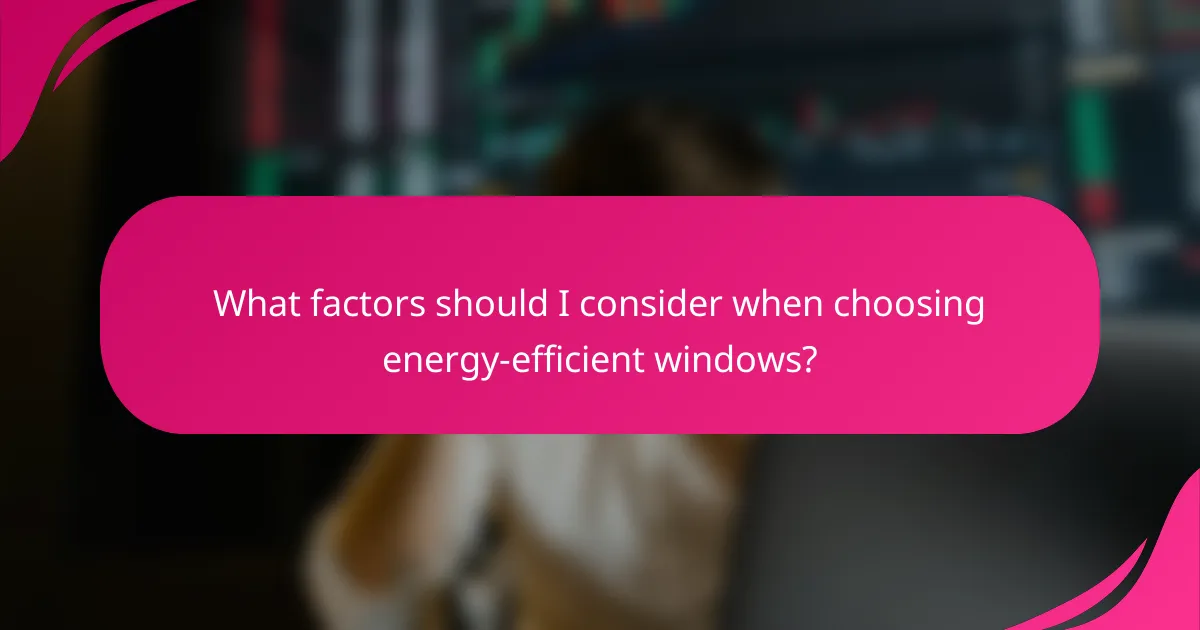
What factors should I consider when choosing energy-efficient windows?
When selecting energy-efficient windows, consider factors such as frame materials, glass types, insulation properties, and local climate. These elements significantly impact energy costs, noise reduction, and UV protection, helping you make an informed choice that suits your needs.
Frame materials comparison
Frame materials play a crucial role in the overall energy efficiency of windows. Common options include vinyl, wood, aluminum, and fiberglass, each with distinct advantages and disadvantages. For instance, vinyl frames are typically low-maintenance and provide good insulation, while wood frames offer aesthetic appeal and natural insulation but require more upkeep.
Aluminum frames are durable and lightweight but may conduct heat, which can reduce energy efficiency. Fiberglass frames are strong and resistant to warping, providing excellent insulation. When choosing a frame, consider your climate and maintenance preferences to find the best fit.
Glass types and their properties
The type of glass used in windows significantly affects energy efficiency. Double or triple glazing, which consists of multiple panes of glass with insulating gas in between, can greatly reduce heat transfer. Low-emissivity (Low-E) coatings reflect heat while allowing light to pass through, enhancing thermal performance.
Additionally, consider the solar heat gain coefficient (SHGC) and the visible transmittance (VT) ratings. A lower SHGC is beneficial in hot climates to minimize heat gain, while a higher VT allows more natural light in. Selecting the right glass type based on your local climate can lead to substantial energy savings and improved comfort.

What are the local incentives for energy-efficient windows in the United States?
In the United States, local incentives for energy-efficient windows typically include federal tax credits and state-specific rebates. These programs aim to encourage homeowners to invest in energy-efficient upgrades, which can lead to significant savings on energy costs and improved home comfort.
Federal tax credits
The federal government offers tax credits for homeowners who install energy-efficient windows that meet specific performance criteria. These credits can cover a percentage of the installation costs, often up to a few hundred dollars, depending on the efficiency rating of the windows.
To qualify, windows must typically meet the Energy Star certification or similar standards. Homeowners should keep receipts and documentation of the installation to claim these credits when filing taxes.
State-specific rebates
Many states provide additional rebates for energy-efficient window installations, which can vary widely in amount and eligibility requirements. These rebates are often designed to complement federal incentives, making the overall investment more affordable.
Homeowners should check with their state energy office or local utility providers to find out about available programs. Some states may require pre-approval or specific documentation, so it’s essential to understand the application process to maximize benefits.
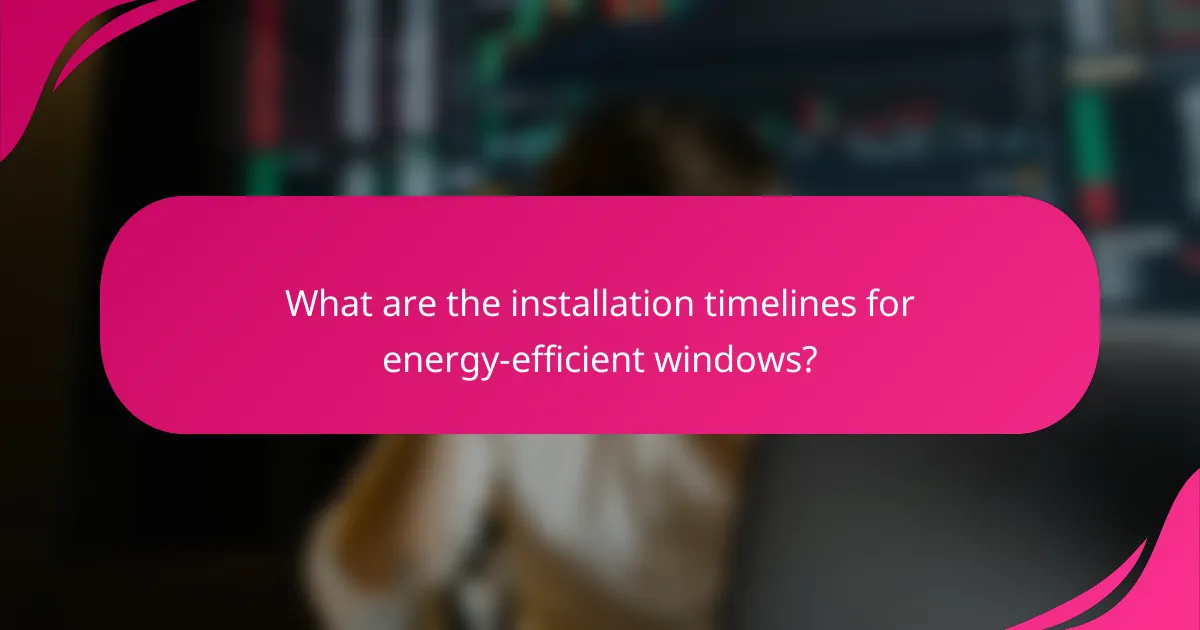
What are the installation timelines for energy-efficient windows?
The installation timelines for energy-efficient windows typically range from a few hours to a couple of days, depending on various factors. Homeowners should plan for at least one full day for installation, especially if multiple windows are being replaced.
Typical installation duration
On average, installing energy-efficient windows can take anywhere from 4 to 8 hours for a standard-sized home with a few windows. If the project involves larger windows or significant structural changes, the timeline may extend to 1 or 2 days. It’s advisable to schedule the installation during favorable weather conditions to avoid delays.
Factors affecting installation time
Several factors can influence the installation time of energy-efficient windows. The number of windows being replaced, the complexity of the installation, and the type of window frame can all impact the duration. For instance, custom-sized windows may require additional time for fitting and adjustments.
Additionally, the experience level of the installation team plays a crucial role. Professional installers may complete the job more efficiently than less experienced workers. Homeowners should also consider any necessary preparatory work, such as removing old windows or repairing surrounding structures, which can add to the overall timeline.
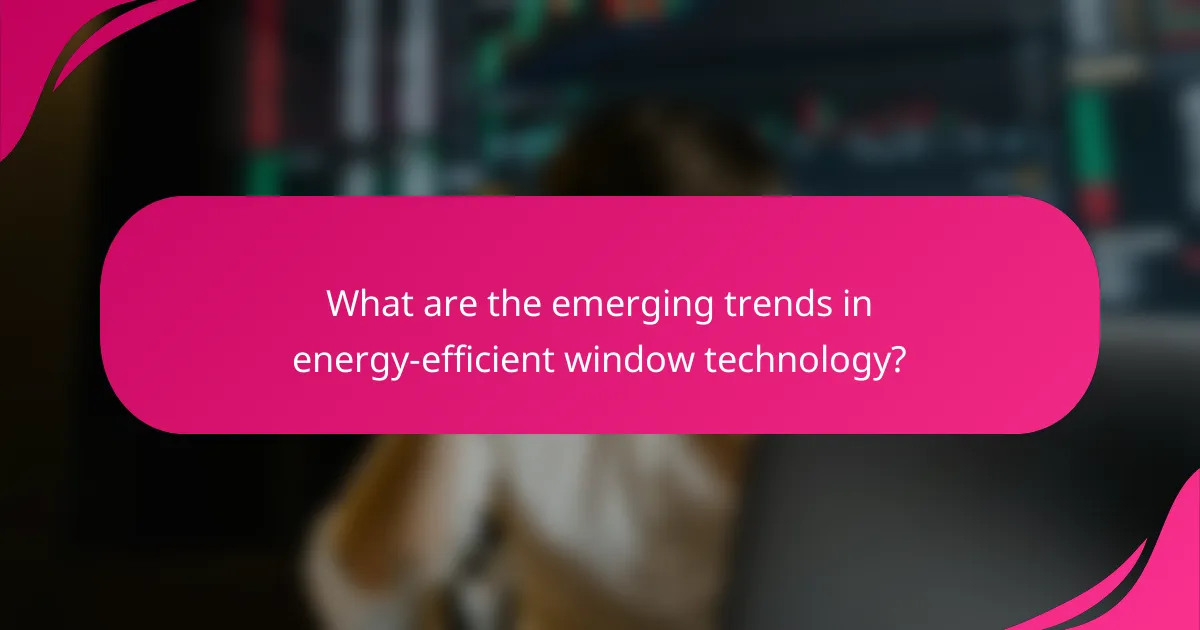
What are the emerging trends in energy-efficient window technology?
Emerging trends in energy-efficient window technology focus on advanced materials, smart features, and enhanced thermal performance. These innovations aim to reduce energy costs, improve indoor comfort, and protect against UV damage.
Smart window technologies
Smart window technologies utilize sensors and automated systems to adjust transparency based on environmental conditions. This capability allows windows to block heat and glare during peak sunlight while maximizing natural light during cooler periods.
Examples include electrochromic and thermochromic windows, which change tint in response to electrical signals or temperature changes. These windows can significantly enhance energy efficiency by reducing reliance on heating and cooling systems.
When considering smart windows, evaluate factors such as installation costs, potential energy savings, and compatibility with existing building systems. While upfront costs can be higher, long-term savings on energy bills often justify the investment.
